
View over Trier with the Trier Cathedral at left and the church St. Gangolf on the right. (814k)
From the Trier entry in Wikipedia:
Trier is a city on the banks of the Moselle in Germany. It lies in a valley between low vine-covered hills of red sandstone in the west of the state of Rhineland-Palatinate, near the border with Luxembourg and within the important Moselle wine region.
Founded by the Celts in the late 4th century BCE as Treuorum and conquered 300 years later by the Romans, who renamed it Augusta Treverorum ("The City of Augustus among the Treveri"), Trier is considered Germany's oldest city. It is also the oldest seat of a bishop north of the Alps. In the Middle Ages, the archbishop-elector of Trier was an important prince of the Church who controlled land from the French border to the Rhine. The archbishop-elector of Trier also had great significance as one of the seven electors of the Holy Roman Empire.
The first traces of human settlement in the area of the city show evidence of linear pottery settlements dating from the early Neolithic period. Since the last pre-Christian centuries, members of the Celtic tribe of the Treveri settled in the area of today's Trier. The city of Trier derives its name from the later Latin locative in Trēverīs for earlier Augusta Treverorum. According to the Archbishops of Trier, in the Gesta Treverorum, the founder of the city of the Trevians is Trebeta. German historian Johannes Aventinus also credited Trebeta with building settlements at Metz, Mainz, Basel, Strasbourg, Speyer and Worms.
The historical record describes the Roman Empire subduing the Treveri in the 1st century BCE and establishing Augusta Treverorum about 16 BCE. The name distinguished it from the empire's many other cities honoring the first emperor Augustus. The city later became the capital of the province of Belgic Gaul; after the Diocletian Reforms, it became the capital of the prefecture of the Gauls, overseeing much of the Western Roman Empire. In the 4th century, Trier was one of the largest cities in the Roman Empire with a population around 75,000 and perhaps as much as 100,000. The Porta Nigra ("Black Gate") dates from this era. A residence of the Western Roman Emperor, Roman Trier was the birthplace of Saint Ambrose. Sometime between 395 and 418, probably in 407 the Roman administration moved the staff of the Praetorian Prefecture from Trier to Arles. The city continued to be inhabited but was not as prosperous as before. However, it remained the seat of a governor and had state factories for the production of ballistae and armor and woolen uniforms for the troops, clothing for the civil service, and high-quality garments for the Court. Northern Gaul was held by the Romans along a line from north of Cologne to the coast at Boulogne through what is today southern Belgium until 460. South of this line, Roman control was firm, as evidenced by the continuing operation of the imperial arms factory at Amiens.
The Franks seized Trier from Roman administration in 459. In 870, it became part of Eastern Francia, which developed into the Holy Roman Empire. Relics of Saint Matthias brought to the city initiated widespread pilgrimages. The bishops of the city grew increasingly powerful and the Archbishopric of Trier was recognized as an electorate of the empire, one of the most powerful states of Germany. The University of Trier was founded in the city in 1473. In the 17th century, the Archbishops and Prince-Electors of Trier relocated their residences to Philippsburg Castle in Ehrenbreitstein, near Koblenz. A session of the Reichstag was held in Trier in 1512, during which the demarcation of the Imperial Circles was definitively established.
In the years from 1581 to 1593, the Trier witch trials were held, perhaps the largest witch trial in European history. It was certainly one of the four largest witch trials in Germany alongside the Fulda witch trials, the Würzburg witch trial, and the Bamberg witch trials. The persecutions started in the diocese of Trier in 1581 and reached the city itself in 1587, where it was to lead to the death of about 368 people, and was as such perhaps the biggest mass execution in Europe in peacetime. This counts only those executed within the city itself, and the real number of executions, counting also those executed in all the witch hunts within the diocese as a whole, was therefore even larger. The exact number of people executed has never been established; a total of 1,000 has been suggested but not confirmed.
In the 17th and 18th centuries, Trier was sought after by France, which invaded during the Thirty Years' War, the War of the Grand Alliance, the War of the Spanish Succession, and the War of the Polish Succession. France succeeded in finally claiming Trier in 1794 during the French Revolutionary Wars, and the electoral archbishopric was dissolved. After the Napoleonic Wars ended in 1815, Trier passed to the Kingdom of Prussia. Karl Marx, the German philosopher and one of the founders of Marxism, was born in the city in 1818.
As part of the Prussian Rhineland, Trier developed economically during the 19th century. The city rose in revolt during the revolutions of 1848 in the German states, although the rebels were forced to concede. It became part of the German Empire in 1871.
The synagogue on Zuckerbergstrasse was looted during the November 1938 Kristallnacht and later completely destroyed in a bomb attack in 1944. Multiple Stolperstein have been installed in Trier to commemorate those murdered and exiled during the Shoah.
In June 1940 over 60,000 British prisoners of war, captured at Dunkirk and Northern France, were marched to Trier, which became a staging post for British soldiers headed for German prisoner-of-war camps. Trier was heavily bombed and bombarded in 1944 during World War II. The city became part of the new state of Rhineland-Palatinate after the war. The university, dissolved in 1797, was restarted in the 1970s, while the Cathedral of Trier was reopened in 1974. Trier officially celebrated its 2,000th anniversary in 1984.
All pictures are © Dr. Günther Eichhorn, unless otherwise noted.




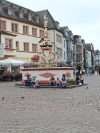

The Porta Nigra (Latin for black gate) is a large Roman city gate in Trier, Germany. It is today the largest Roman city gate north of the Alps.
The name Porta Nigra originated in the Middle Ages due to the darkened color of its stone; the original Roman name has not been preserved. Locals commonly refer to the Porta Nigra simply as Porta.
The Porta Nigra was built in grey sandstone after 170 CE. The original gate consisted of two four-storeyed towers, projecting as near semicircles on the outer side. A narrow courtyard separated the two gate openings on either side. For unknown reasons, however, the construction of the gate remained unfinished. For example, the stones at the northern (outer) side of the gate were never abraded, and the protruding stones would have made it impossible to install movable gates. Nonetheless, the gate was used as a town entrance for centuries until the end of the Roman era in Trier.
In Roman times, the Porta Nigra was part of a system of four city gates, one of which stood at each side of the roughly rectangular Roman city. It guarded the northern entry to the Roman city, while the Porta Alba (White Gate) was built in the east, the Porta Media (Middle Gate) in the south, and the Porta Inclyta (Famous Gate) in the west, next to the Roman bridge across the Moselle. The gates stood at the ends of the two main streets of the Roman Trier, one of which led north-south and the other east-west. Of these gates, only the Porta Nigra still exists today.
In the early Middle Ages the Roman city gates were no longer used for their original function and their stones were taken and reused for other buildings. Moreover, iron and lead braces were broken out of the walls of the Porta Nigra for reuse. Traces of this destruction are still clearly visible on the north side of the gate.
After 1028, the Greek monk Simeon lived as a hermit in the ruins of the Porta Nigra. After his death (1035) and sanctification, the Simeonstift monastery was built next to the Porta Nigra to honor him.
To save it from further destruction, the Porta Nigra was transformed into two superimposed churches with identical floor plans. The upper church was accessible to the monks and the lower church was open to the general public.
The church naves were created by extending the first and second floors over the inner courtyard. An apse was constructed onto the east tower. Additional levels and a spire were added to the western tower. The top floor of the eastern tower was removed, and a new clerestory level was built over the nave, east tower and apse. Windows of the western tower were enlarged to become entrance doors (still visible today).
The ground floor with the large gates was buried inside a terrace, and a large staircase was constructed alongside the south side (the town side) up to the lower church. A small staircase led further up to the upper church.
An additional gate (the much smaller Simeon Gate) was built adjacent to the East side of the Porta Nigra and served as a city gate in medieval times.
In 1802, Napoleon Bonaparte dissolved the church in the Porta Nigra and the monastery beside it, along with the vast majority of Trier's numerous churches and monasteries. On his visit to Trier in 1804, Napoleon ordered that the Porta Nigra be converted back to its Roman form. The clerestory level and church tower were deconstructed, and the inner courtyard was reinstated. However, the apse was preserved in a truncated form, and the eastern tower was not rebuilt to its original height. The terrace surrounding the ground floor level was removed.
Local legend has it that Napoleon originally wanted to completely tear down the church, but locals convinced him that the church had actually been a Gaulish festival hall before being turned into a church. Another version of the story is that they told him about its Roman origins, persuading him to convert the gate back to its original form.
The Porta Nigra is part of the UNESCO World Heritage Site Roman Monuments, Cathedral of St Peter and Church of Our Lady in Trier.

The Aula Palatina, also called Basilica of Constantine (German: Konstantinbasilika), at Trier, Germany, is a Roman palace basilica that was commissioned by the emperor Constantine I (CE 306–337) at the beginning of the 4th century.
Today it is used as the Church of the Redeemer and owned by a congregation within the Evangelical Church in the Rhineland. The basilica contains the largest extant hall from antiquity and is ranked a World Heritage Site. The hall has a length of 67 m (220 ft), a width of 26 m (85 ft) and a height of 33 m (108 ft). It is part of the UNESCO World Heritage Site Roman Monuments, Cathedral of St Peter and Church of Our Lady in Trier.
The Aula Palatina was built around CE 310 as a part of the palace complex. Originally it was not a free-standing building, but had other smaller buildings (such as a forehall, a vestibule and some service buildings) attached to it. The Aula Palatina was equipped with a floor and wall-heating system (hypocaust).
During the Middle Ages, it was used as the residence for the Bishop of Trier. For that, the apse was redesigned into living quarters and pinnacles were added to the top of its walls. In the 17th century, the archbishop Lothar von Metternich constructed his palace just next to the Aula Palatina and incorporated it into his palace doing some major redesign. Later, in the 19th century, Frederick William IV of Prussia ordered the building to be restored to its original Roman state, which was done under the supervision of the military architect Carl Schnitzler. In 1856, the Aula Palatina became a Protestant church. In 1944, the building burned due to an air raid of the allied forces during World War II. When it was repaired after the war, the historical inner decorations from the 19th century were not reconstructed, so that the brick walls are visible from the inside as well.




From the Trier Cathedral entry in Wikipedia:
The High Cathedral of Saint Peter in Trier (German: Hohe Domkirche St. Peter zu Trier), or Trier Cathedral (German: Trierer Dom), is a Roman Catholic cathedral in Trier, Rhineland-Palatinate, Germany. It is the oldest church in Germany and the largest religious structure in Trier, notable for its long life span and grand design. The central part of the nave was built of Roman brick in the early fourth century, resulting in a cathedral that was added onto gradually in different eras. The imposing Romanesque westwork, with four towers and an additional apse, has been copied repeatedly. The Trier Cathedral Treasury contains an important collection of Christian art.
The Trier Cathedral is part of the UNESCO World Heritage Site Roman Monuments, Cathedral of St Peter and Church of Our Lady in Trier.
According to certain sources, the cathedral was commissioned by Emperor Constantine the Great and built on top of a palace of Saint Helen, his mother. Following the conversion of Constantine to Christianity, bishop Maximin (329-346) is said to have coordinated the construction of a cathedral, which at the time was the grandest ensemble of ecclesiastical structures in the West outside Rome. On a ground plan four times the size of the present cathedral no less than four basilicas, a baptistery and outbuildings were constructed. Archaeological research confirms that the current cathedral, as well as the adjacent cloisters and Church of Our Lady, is raised upon the foundations of ancient Roman buildings of Augusta Treverorum. The four piers of the crossing of the present church, as well as parts of the brick outer walls are remnants from this period.
The fourth-century church was left in ruins by the Franks but rebuilt. It was destroyed again by the Vikings in 882. Under Archbishop Egbert (d. 993) rebuilding started, completed by Poppo of Babenberg (1016-1041). The famous west façade dates from this period, although the apse was not finished until 1196. Throughout the centuries the church continued to be rebuilt and embellished, according to the fashion of the period with Gothic vaults, Renaissance sculptures and Baroque chapels, but the overall style of the building remains Romanesque with a Roman core.



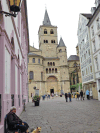
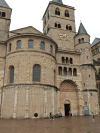

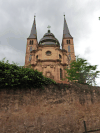
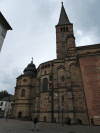
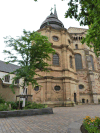
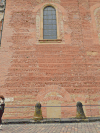


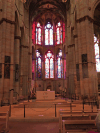

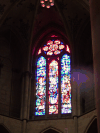
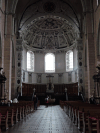

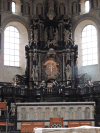
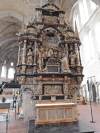
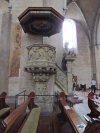
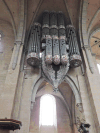
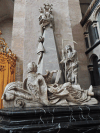
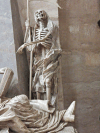
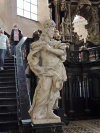


From the Liebfrauenkirche, Trier entry in Wikipedia:
The Liebfrauenkirche (German for Church of Our Lady) in Trier, is, along with the Cathedral of Magdeburg (reportedly begun in 1209, but finished after the Liebfrauenkirche) the earliest Gothic church in Germany and falls into the architectural tradition of the French Gothic cathedrals. It is located next to the Trier Dom.
A Roman double church originally stood here. The southern portion was torn down around 1200 and completely replaced by the Early Gothic Church of Our Lady (Liebfrauen).
The exact date of the start of construction can no longer be determined, however a painted inscription inside on a column in the church reads: "The construction of this church was started in 1227 and ended in 1243", however, it is currently thought construction began in 1230 by Archbishop of Trier Theodoric II (also called Dietrich von Wied or Theoderich von Wied).
Around 1260, the building was probably finished. In 1492, a high peak was placed on the central tower, which was named because of its high technology and degree of craftsmanship perfection. The high peak can be seen on the city dating, but was destroyed in a storm on Heimsuchungstag (July 2) in 1631. Subsequently a hipped roof emplaced, which was destroyed in the Second World War. It was first replaced in 1945 by a roof and then by a steeper one in 2003.
On July 13, 1951, Pope Pius XII designated the church a Minor Basilica.
The Liebfrauenkirche is part of the UNESCO World Heritage Site Roman Monuments, Cathedral of St Peter and Church of Our Lady in Trier.
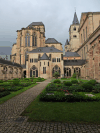



From the Trier Imperial Baths entry in Wikipedia:
The Trier Imperial Baths (German: Kaiserthermen) are a large Roman bath complex in Trier, Germany. It was constructed in the 4th century AD. They were never finished and actually used.
The Imperial Baths are part of the UNESCO World Heritage Site Roman Monuments, Cathedral of St Peter and Church of Our Lady in Trier.

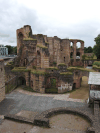






From the Trier Amphitheater entry in Wikipedia:
The Trier Amphitheater is a Roman amphitheater in Trier, Germany.
Trier and its amphitheater resembled many Roman cities of its time in that many infamous gladiatorial contests occurred there. The structure which was dug into the side of a hill was erected around the 2nd century CE during Antoninus Pius' rule. It could accommodate approximately 20,000 spectators and was built into what was the city's wall. When Constantius Chlorus moved to Trier, Germany around 293 he renovated the amphitheater.
Below the arena are cellars. They contain elevators to lift the actors into the arena.
The multiple usages of the arena included gladiator events and animal shows in which a cellar under the arena was utilized to store the animals and sentence prisoners to death.
The Amphitheater is part of the UNESCO World Heritage Site Roman Monuments, Cathedral of St Peter and Church of Our Lady in Trier.



This page contains 52 pictures

Main page for Deutschland (Germany)
Page last updated on Wed Jul 14 11:35:49 2021 (Mountain Standard Time)
Page last updated on Wed Apr 24 15:44:12 2024 (Mountain Standard Time)